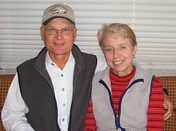Because We Can - Fulltime RV'ing
- Ruthsarian :
- Home :
- Today's Journal :
- Where We Are #2917 :
- Who We Are :
- Contact Us :
Journal Archive 6/11 - 6/20 2009
Scroll down to read the latest post
June 11 Thursday
Traveling and not doing much of anything

This was going to probably be our last healthy breakfast for a while, so we did it in real style. Unfiltered cherry juice, a strawberry smoothie, a radish and green onion cream cheese spread, and number of the old stand-bys. We are by now so used to such wonderful breakfasts, it may be be a real shock next month when we are London, and the breakfasts are completely different. Oh let us be wrong there, let us be wrong. Hardy and healthy breakfasts, we delight in you.

Walking to the tram stop, we caught our last glimpse of that famous Polish hero, Charles De Gaulle. Decades before he became the French President, De Gaulle helped Poland defeat Russia and gain their independence between the two world wars. His statue stands on the square named after him in recognition of those efforts.
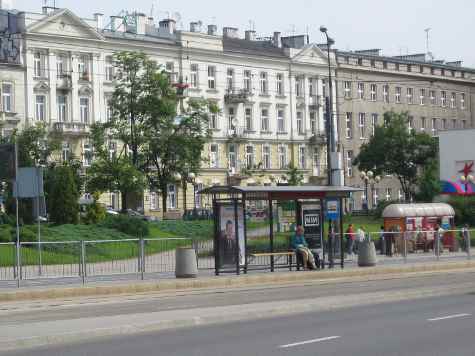
Since our three day transit passes had expired, we needed tickets for the short ride down to the train station. These are inexpensive and available from any Ruck, which are small stands found throughout the city. Of course the closest one would have to be closed, so while Linda wanted at the stop, I walked down the street to one that was open.

Things always seen to take longer than you think, and while it was only few minutes until I was back, it seemed far longer. With tram after tram rolling by, complete with all the noise we had come to understand was part of the experience.

On board the tram, we needed to stamp our tickets. Linda is holding on for dear life with the one hand while she tries to stamp her ticket with the other. Riding the tram is something like being on a carnival ride with the exception that there is no seatbelt to keep you from flying all over the place. On crowded trams the other people serve that function, but this one was nearly empty so it was hang on for three stops and get off at the train station.
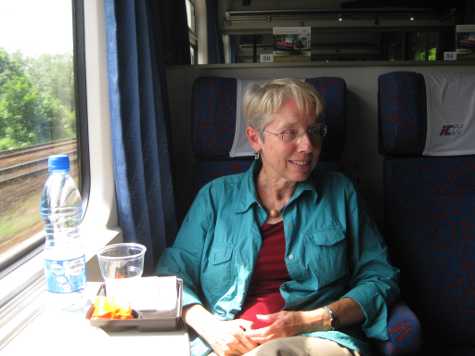
One of the things we had read about Polish trains was that they were almost always late. Our train to Krakow was no exception. The problem was that Linda had timed her restroom requirements on the basis of the train being on time, and with each passing moment, as we stood and waited, the situation got more critical.
Guaranteeing the train would almost immediately arrive, she headed off to find relief. As she returned, she saw me standing with all our packs, frantically waving. I knew that girl could run, it was simply that she hadn't ever been motivated properly. This was that motivation, and run she did.
Luck was with us, our car was directly in front of where I was standing, and within seconds of boarding the whistle blew and we were off. The difference between first and second class was just a few dollars so we had first class tickets. The compartment seated six, and again there was only one other person with us.
She was a lovely young Polish woman who spoke very good English, and we had a wonderful time learning much about Poland during the trip. Afterwards Linda commented there must have been a young man waiting for her at Krakow, because every time she received a text message during the trip, she would burst out into the most beautiful smile.

While Krakow is a city of over 750,000, the main attraction for tourists is the the old town square. By far the largest we have seen in Europe, it also had by far the most people. Our bed and breakfast was located on the edge of the square, and even though it took a little hunting, and far more walking than Linda would have preferred, we eventually found it.
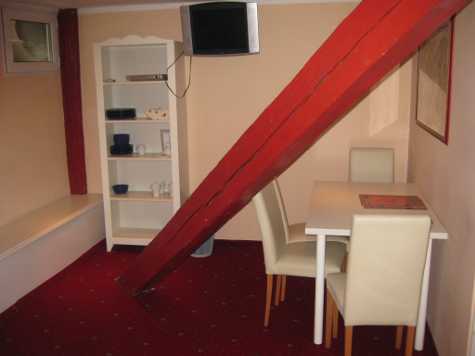
It turned out to be another apartment, and even had a second bedroom. It was also in a 500 plus year old building, so we understood the steep staircase and the beam through the middle of the main room. It was also our kind of place, not the sterile four star room that looks like all the other four star rooms, rather it was one to remember with a chuckle and a smile.
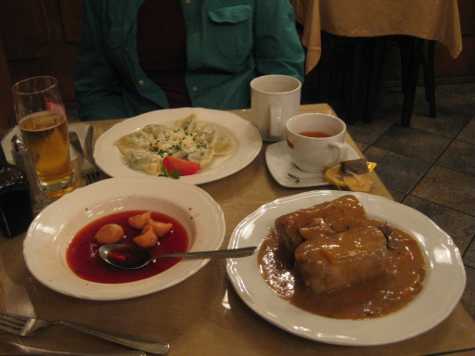
When it came time to eat we opted for some traditional Polish food at a small cafeteria Rick Steves recommends in his book. It was the perfect choice, and Linda had pierogi dumplings and also a cup of clear borscht soup, while I had a bowl of borscht with small dumplings in it, and a huge plate of cabbage rolls. The food was beyond wonderful, and we both left stuffed to the gills.

The day ended with a laugh. Linda had been fighting a headache all day long, and as she relaxed catching the latest world news, she complained that her eyes were hurting because of the lights in the room. I was busy writing the Daily Journal, or rather trying to get caught up, as I had fallen behind, when I turned around and saw this.
One could look at this as a brilliant solution to her problem, or that she has a serious problem, and it wasn't with the lights. Sometimes when things don't go the way you expect, you just have to think outside the box. This was definitely one of those times.
June 12 Friday
Oswiecim
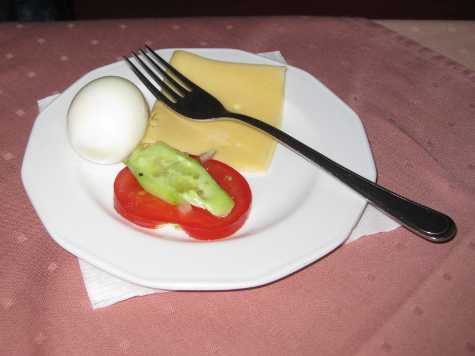
A much simpler breakfast than we have been having the last few mornings.Yet compared to the food that would have been served at where we were going for the day, our breakfast was a feast beyond imagining.
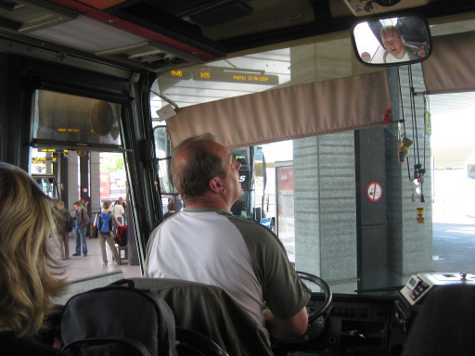
The town of Oswiecim is about 50 kilometers from Krakow, and to get there we took the bus. It took us a while to find out where the bus stopped, and this was at the bus station, but once we did, we boarded and bought our tickets from the driver. It was 10 Zloty each, one way, for the trip, or roughly 12 dollars US for both of us to go round trip.
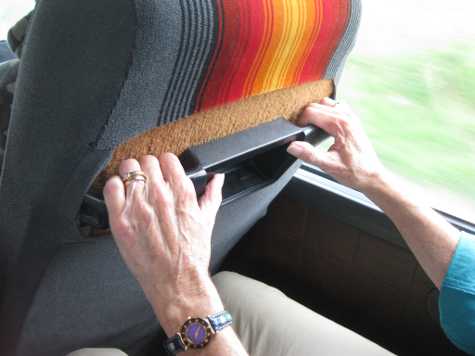
The bus ride took nearly two hours, as there were many stops along the way. It was also one of the things that you have to experience in order to appreciate. First was the ride itself. The roads were fairly narrow, and in places quite curvy, meaning that it was something that could make Linda a little sick as she says. It did make a little boy on board sick, though his dad got him off before anything happened. Linda's method of stomach control was to hang onto the seat in front of her. a good idea and it worked.
The second thing was the number of passengers. Every seat was full and so was the aisle. Linda had the window seat, so I at various times had interesting body parts being bounced and flounced in front of my face or into me. Like the saying, it was something you had to experience to appreciate.

The same words we have seen before, only this time it was the gate that lead into Auschwitz, the memorial we would be visiting today. Holding some 14,000 people, this concentration camp was a place of death by exhaustion from overwork, disease, medical experiments, gas, beating, torture, starvation, hanging, shooting and any other means the Nazi SS could devise. It was also the place where the experiments with Zyklon B gas were carried out, using Russian prisoners of war, to determine the most effective way to deal with the so called, Jewish problem.
Our words and photos can not begin to show the horror that was this place. First developed as a memorial by the Communists, and thus many of the exhibits still have a strong socialist slant, it is primarily a place of feelings. When someone in our country speaks with great anger about "those people" whoever those people might be, one only has to be here and see what that anger can ultimately lead to.
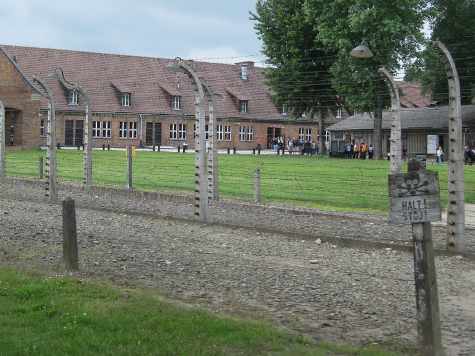
Death zone and electrified barbed wire fence.

Empty cans that once held the Zyklon B gas used to murder some 700 people at a time in the camp's gas chamber. However, the capacity of the crematorium, 340 per day, limited the number of mass killings that could be done. In addition there was the constant stream of bodies from all the other murders that took place in the camp, plus those that died of overwork, exhaustion and other causes.
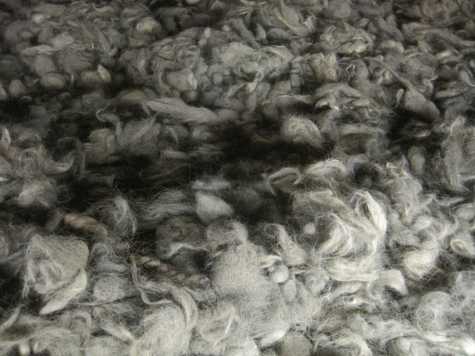
The women's heads were shaved, the same as the men, but in the women's case, their hair was saved to sold to a textile company which used it to make cloth for the German military. The buildings in the camp are brick, and the camp itself, originally a Polish Army camp, was enlarged by prison labor. The buildings are called blocks, and in them are different types of exhibits. What follows is a very brief look at a very tiny fraction of the exhibits we saw. We spent over 5 hours in the camp and saw maybe half of all the exhibits. For some, a glance is enough, for others, us included, it requires looking, reading and trying to understand.
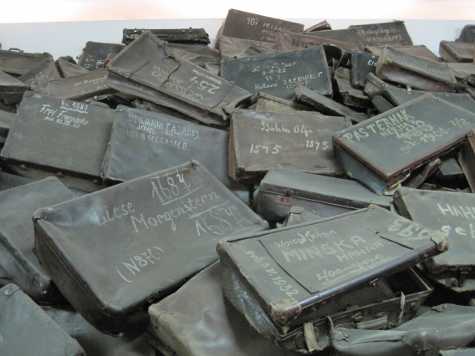
Piles of suitcases.
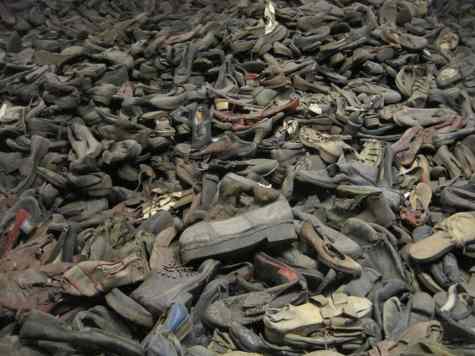
Endless numbers of shoes.

Prisoners washroom. Sanitation was important only because it kept the prisoners from getting diseases that might spread to the Nazis.
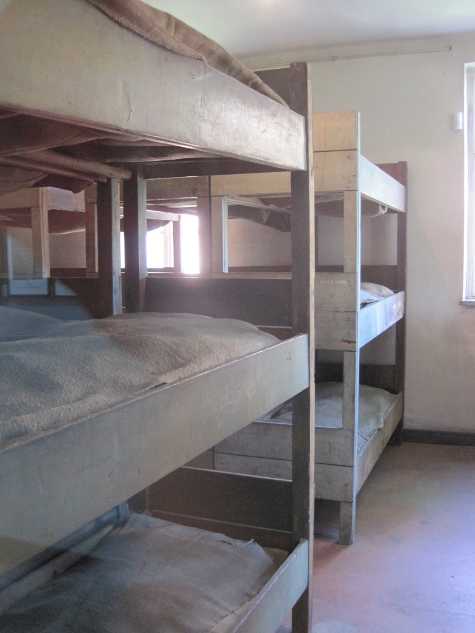
Bunks with straw mattresses. Several or more prisoners shared one bunk.
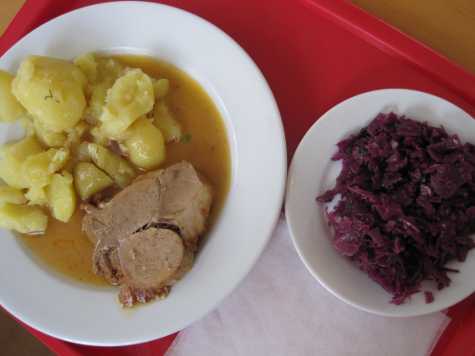
This had been Linda's lunch today. Contrast it with the watery soup and piece of bread the prisoners received.

The electrified barbed wire fences were a very effective means of control. Note the guard tower above Linda's head with the clear view of the area between the fences. Prisoners who wanted to commit suicide only need get near the fences, and the guards would open fire.
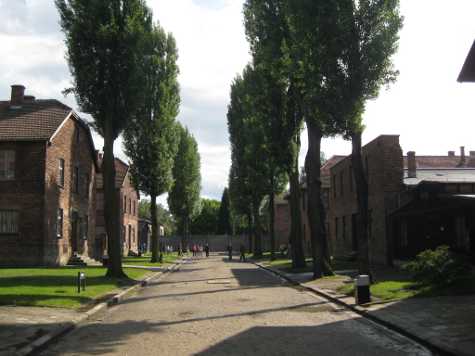
Looking down one of the streets showing the blocks. It looks similar to what it was like during the time it was used by the Nazis, with the exception that there would have been no grass, only dirt around the buildings. Underfoot was dirt, dust, mud or rocks,and when they suffered a shortage of shoes, the Nazis requested more shoes as it interfered with the prisoners ability to work, as most of the prisoners worked outside the gates during the day.

Gallows where the former camp Commandant, Rudolf Hoss was hanged for his crimes. It is located where the camp Gestapo building once stood. The former prisoners requested Hoss be hanged in Auschwitz, just as many of the inmates were. The gallows has been purposefully left to serve as a reminder to all who see it. His wife reportedly said that by hanging her husband at Auschwitz it ruined all the wonderful memories she had of her family's life while they lived at Auschwitz.

As we wanted for the bus to take us back to Krakow, this was the pleasant scene we saw. Yet just hundreds of feet behind those trees some of the greatest cruelties ever inflected upon humans took place. It had been a trying day emotionally for both of us and there was only dinner and sleep for us tonight, because tomorrow we would journey to a place where even more unspeakable horrors than what we had seen today took place.
June 13 Saturday
Back to Oswiecim
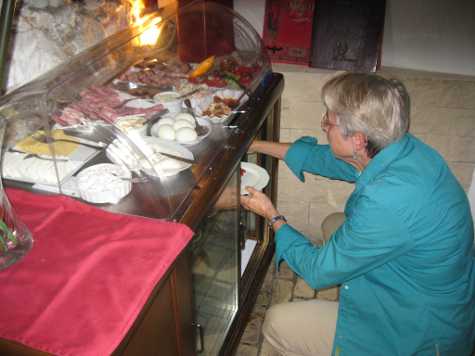
There is top shelf food, and there is bottom shelf food. Linda was into fruit and yogurt this morning, and while it was on the bottom shelf, it wasn't bottom shelf food.

Our plan was to return to Oswiecim again today, which we did, but with a slight change in plans. We were going to take the bus, but our lack of knowledge of Polish caught up with us. Yesterday we checked the schedule and it showed the earliest departure at 8:40. When we arrived at the bus station there was no bus, and it turned out that the words we couldn't understand said it only ran Monday thru Friday.
The same was true of the next bus, meaning the best way to get to Oswiecim was via the train. When we arrived at the station, the schedule showed a train leaving in two minutes so we hurried on board and bought our tickets from the conductor when he came through the car.
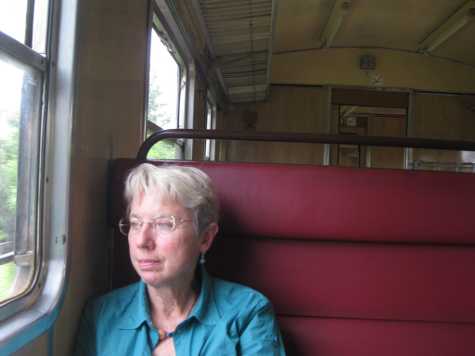
As we rode along in modern day comfort, we had to think back some 66 years ago to the people who may have ridden, packed into a cattle car, along these same tracks. But while we knew what our destination was, they didn't, often times only being told they were being taken to some unknown place for resettlement..
When we arrived at the station in Oswiecim, we followed the people in front of us across the tracks and to the station. From there it was about a 20 minute walk to our destination, but due to pressing problem requiring relief on Linda's part, we took a taxi instead. So much for reliving history, but Linda was certainly a happy girl.
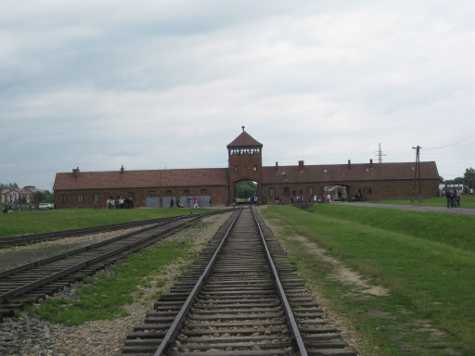
You've seen it in books, on TV and in the movies. It is the entrance to Birkinau, also known as Auschwitz-Birkinau, or Auschwitz.II. The largest and most notorious of the Nazi death camps. A place where over one million men, women and children were murdered.
This view is taken from inside the gates where train loads of people entered with no thought of what awaited them. The size of the camp is mind boggling. It could hold almost 100,000 human beings, and was being expanded right up until it was closed down as the Russian Army approached in lthe winter of 1944-45. It was designed to be an extermination facility, and it vert effectively functioned as an extermination facility.
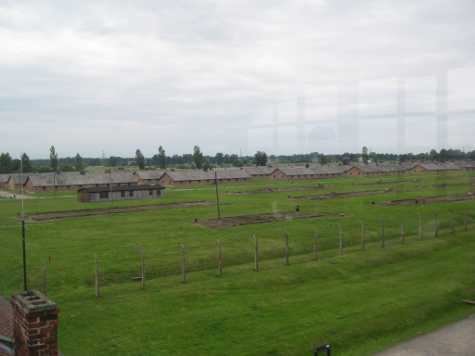
From the top of the main building, the view to the left shows row upon row of brick buildings, one of which housed the children Nazi Doctor Mengele used in his horrific medical experiments. This however is the small side of the camp. The view to the right is almost beyond comprehesion.

The reflection from the window galss makes it hard to see, but there is a veritable forest of brick chimneys strectching all the way to the trees at the back of the photo.The buildings on this side were constructed later, following the plans for horse barns for the German Army's horses, and were built of wood. Long since destroyed, with a few rebuilt to show what they were like, the concrete foundations and bricks are all that remain.
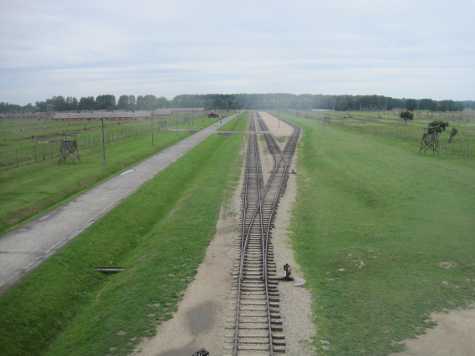
The railroad sidings where the dividing took place. When the trains came to a stop on the sidings, everyone on board was lined up into two groups. Men and older boys in one, women, girls and children in the other. As they passed a Nazi doctor, he directed the ones deemed fit to work, or suitable for other uses, I.e. medical experiments,etc., towards the road to the barrack buildings. All the others were sent immediately to the gas chamber.

One of the brick barrack buildings.
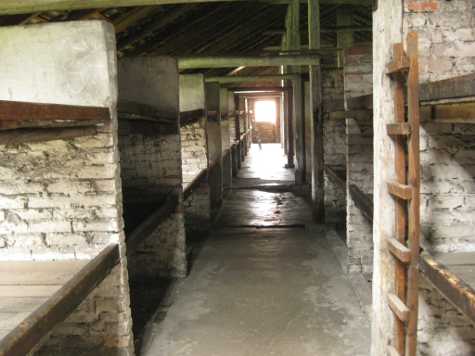
Sleeping bunks were three levels high,with the lower bunk on the ground. Physical comfort of the prisoners was of no concern since everyone brought to camp was destined to die anyway..

Size of the bunks, though that is hardly the word to describe the small space that five prisioners shared.

A Latrine, prisoner personal privacy did not exist. The latrines did give another type of privacy. The smell was so bad the Nazi guards would not enter, thus giving the camp underground a place pass messages and information.
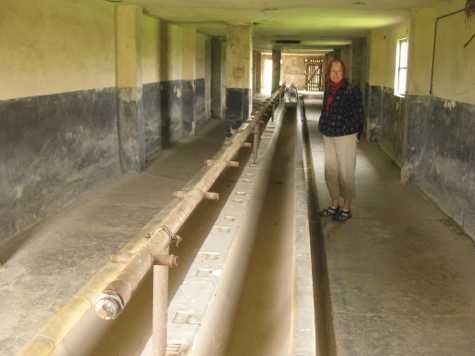
Washroom, note indentation in the tile, apparently for a bar of soap. Sanitation helped prevent disease, not for the health of the prisoners, but so it wouldn't spread to the Nazis.
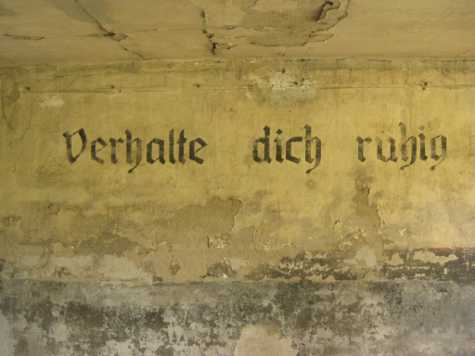
Sign on the washroom walls..
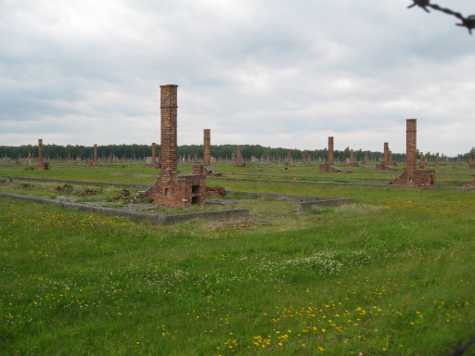
The other side of the camp with the brick forest that stands in silent testimony to the horrors that took place.
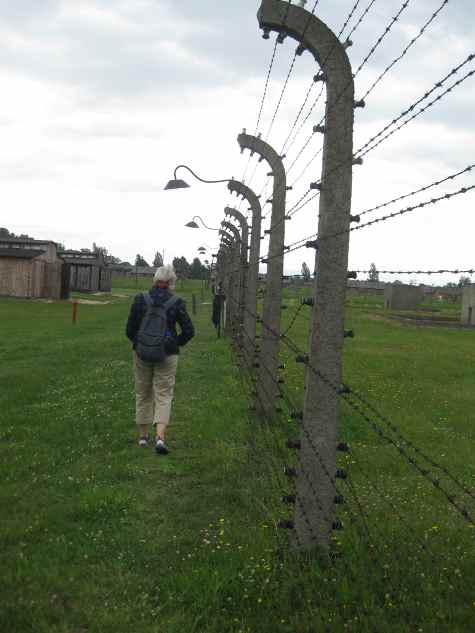
Electrified barbed wire was used to separate the blocks.
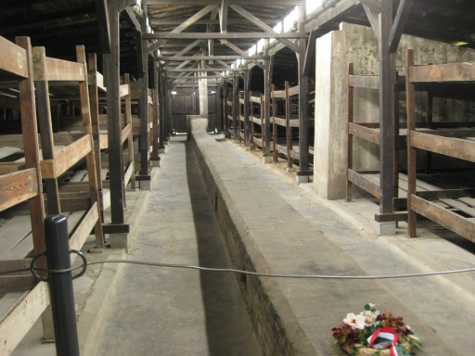
Interior of a reconstructed wooden barracks.
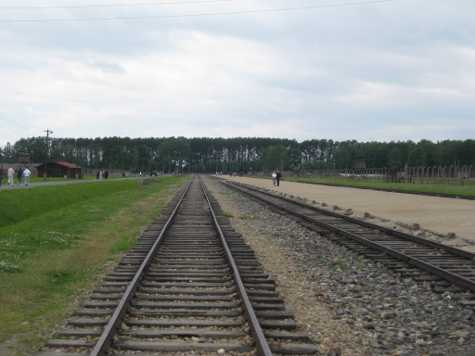
Where the people got off the train.
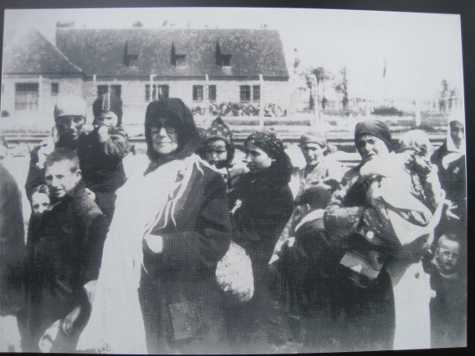
Nazi photo of a group of women and children walking to the gas chamber. It is impossible to describe the emotions one feels walking along the road they took.
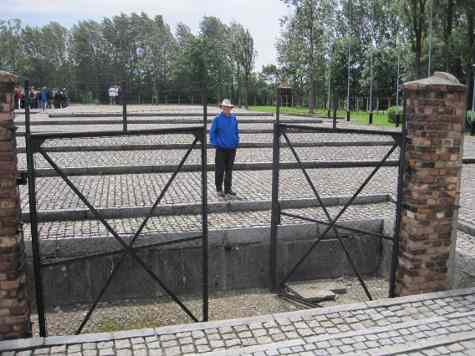
Gate leading to one of the gas chambers and creamatoriums.
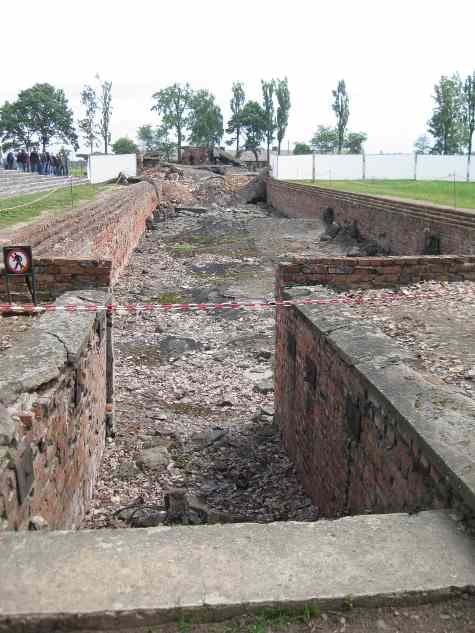
Steps going down to the undressing room, gas chamber, and crematoria. The Nazi dynamited it after dismantling what the could as the Soviet Army approached towards the end of the war.

Looking at this, there is a reason why they call what was done here, crimes against humanity. There are many other terms to describe what took place, but it is so overwhelming when you stand here, words fail. I have to wonder how many visitors thought as I did, may this never happen again. It is a place where when you look at the photos you took, you realize you didn't take nearly as many as you thought. Nor did you take them of many of the things you saw. It was that kind of place. Emotions take over as you walk the grounds.
There are people who deny what took place. Having been here I realize that they don't deserve my contempt, they deserve nothing, for to deny this you have to less than human. But wait, everyone is entitled to their opinion. I bet dung beetles are of the opinion they can roll the biggest ball of dung. Someone who denies this belongs on a far lower scale than the dung beetle. Stand beside the pits full of human ashes for a few moments, look at the tiny bone fragments laying on the ground. Look and say, never again, because next time it may be me, it may be another human being, just as it once was.
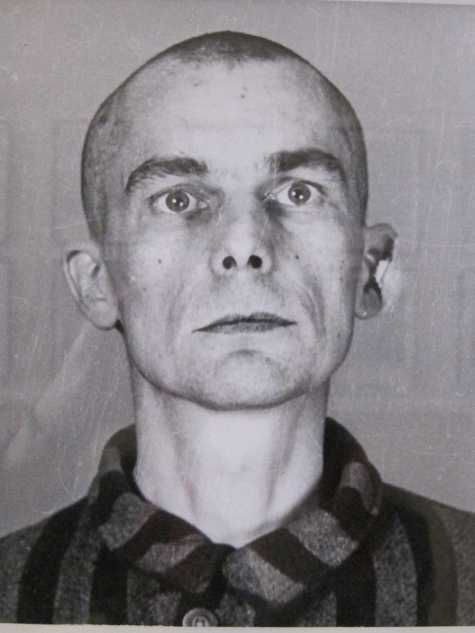
June 14 Sunday
Down to breakfast, around town, Internet time, fun and games, Krakow at night
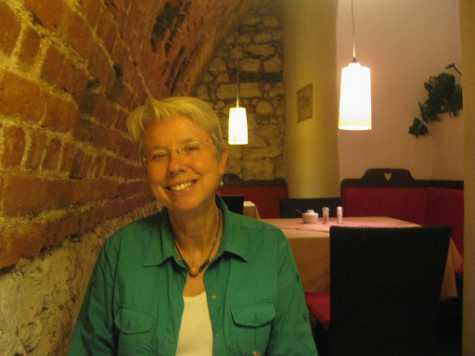
Breakfast is down in the basement of the building. While many tourists probably look at these cellar eateries that are found around old town Krakow a delightful experience, Linda would use other words to describe them. At least to describe the descent down into their depths.

Leaving our room we face two sets of carpeted steps.
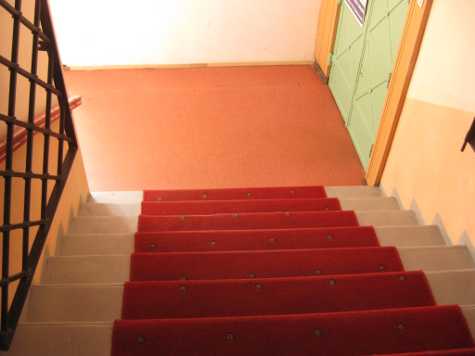
At the landing we go through a locked door, then down a set of marble steps that have a carpet runner.
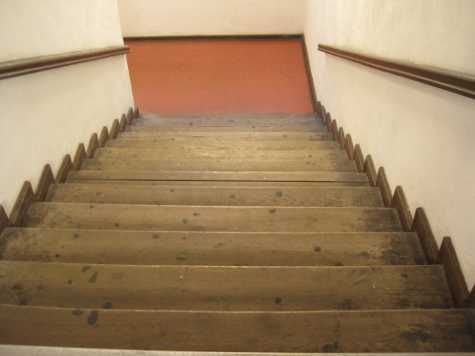
Now comes four sets of wooden stairs. They can be an interesting challenge because not all of the steps are the same height.

Next there is a hallway which ends in another locked door. Going through this door you are at street level. From here there is a short passageway that leads out to the street

Instead of going outside, we go through a doorway on the left side of the passageway, and start down some brick steps.

Another set of bricks steps.

Finally at the bottom, food is directly ahead. Though this building was rebuilt after the war, there are no elevators. That may have something to do with the fact the war in question took place in 1241, and the building is some 700 years old. My comments to Linda that the stairs helped burn off the extra weight we gained from the food, fell on deaf ears.

The main square was filled with people.
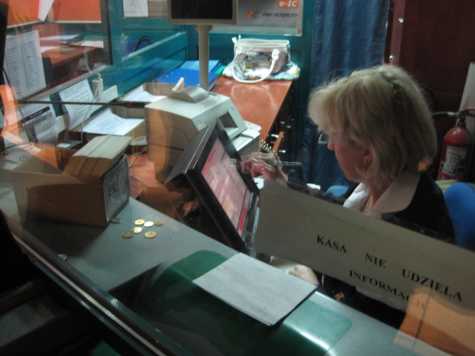
Deciding that standing in a mass of people, listening to things we didn't understand wasn't the best use of our time, we headed off to the train station. Buying two tickets in first class, that would take us to the German border was accomplished by writing down the names of the two towns. An arrow from Krakow to our destination was for a one way ticket. 1 Klasse for 1st class and 15-6-09 for the date got us exactly what we wanted at the price we had from the PKP website. PKP being the name of the Polish national railroad company.
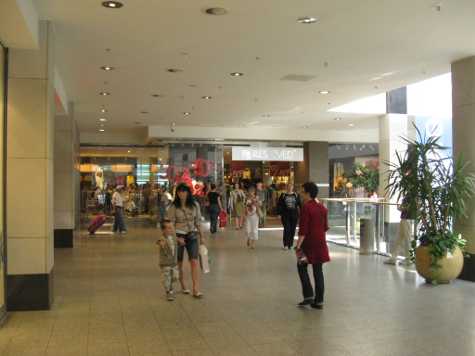
Leaving the station, we took the shortcut through a huge indoor shopping mall. Being regular stick in the mud's, we decided it was also too crowded and headed off to someplace quiet.

I was still several days behind with my Daily Journal, but taking advantage of the chance to post, up went what was done. It also gave us a chance to read our email. We also did some research on our next destination, which was Gorlitz, Germany, on the border with Poland.

Walking down the street, I discovered I was talking to myself. Heading back the way I came, I discovered Linda had somehow got trapped in a line.

It wasn't long till the mystery was solved. She reported the chocolate ice cream was very good indeed.
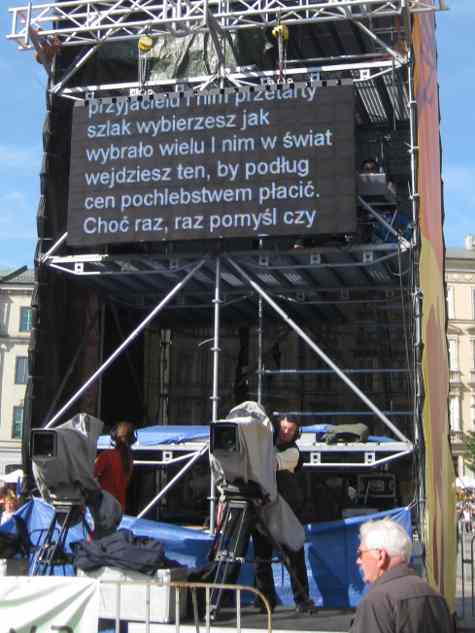
Back at the square they were have a karaoke contest, which was being taped for a later showing on TV. We watched for a while, but the long waits while the stage manager positioned the contestants so they were in the right spot, got to be a little too much.

What started out as a break turned into dinner, With several courses it ended up being a candle light dinner. Sometimes the way things turn out is far better than expected. This was one of those times.

Our bill for the meal. To convert from Zloty into dollars, divide by 3.2. As for the Polish, you're on your on.
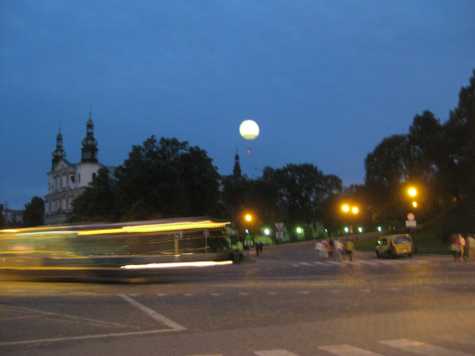
Later, to burn off a few calories, we were taking a walk down to the castle, when a strange sight appeared. It wasn't the moon, it was a hot air balloon, It made for one of those, got to take a photo of this moments. Just as I took the photo a bus drove past, making the unusual blur at the bottom. What a day it had been,and to think, Linda still had the fun of climbing all those stairs to look forward to when we got back to the bed and breakfast, poor baby.
June 15 Monday
Seven hours on the train, back in Germany
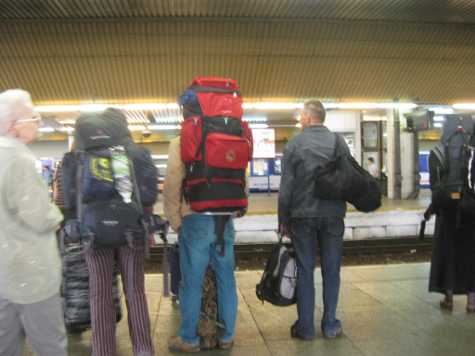
During the night it rain, but had stopped by 6:45 when we left for the train station, We left long before breakfast was serves, but we also went down those steps for the last time. Linda looked t both as good. No weight gain from too much food, and no more trips back up those stairs. Being Monday morning , the station was fairly crowded, and our train, which went to Wroclaw, had a large group of backpackers waiting to board.

Our train was a local, not an intercity express, which made for more stops, and also put us in an older car. On occasion someone would sit in our compartment, but most of the trip we were alone. As we traveled there was a type of tower that appeared every once in a while, which at one time might have had something to do with the railroad. maybe they were water towers from the days of steam locomotives, or maybe they didn't have anything to do with the railroad. I certainly had no clue, and I'm sure Linda didn't either.

While I was looking out the window, Linda was busily engaged in her on activity. That being getting caught up on the sleep she missed because of the need to get up early to catch the train. How she could sleep with all the noise, plus the jerking back and forth of the car, the roadbed leaving much to be desired, probably had something to do with the sonorous blasts she was busily engaged in issuing.
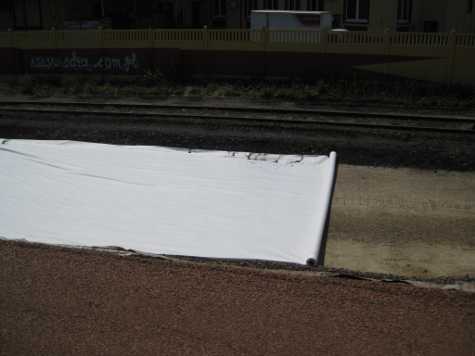
While we passed kilometer after kilometer of grain fields, the train would speed, up and slow down. It was because the roadbed was in such bad shape in some areas, and at other times it was because we were passing over a siding switch. As we approached Worclaw,the train greatly speeded up,and looking out the window it was apparent why.
That's one of my former lives in the white. Rebuilding the roadbed with geotextile fabric was making a huge improvement. Very poor railroads, another legacy from the communist days. I remember the comment of the person who checked us into our first bed and breakfast in Poland. when we said the train had gotten in early, she told us it couldn't have been a Polish train, but must have been a German train, as Polish trains are always late. She was right.

The train station in Wroclaw. Glowny means main. Here we switched trains, being a little confused since our tickets listed no train numbers. we asked the conductor who was standing on the platform, and although he spoke no English and we no Polish, by pointing, we communicated and got on the correct train. Let's just say the train info on the overhead platform signs left a little to be desired.

Getting off in the Polish border town of Zgorzelec, we took a brief taxi ride to a pedestrian bridge that crossed the river to Gorlitz, Germany. A short walk, a visit to the TI to find a room for our stay, another, even shorter walk, and we were at the guesthouse where we would be spending the next three nights.
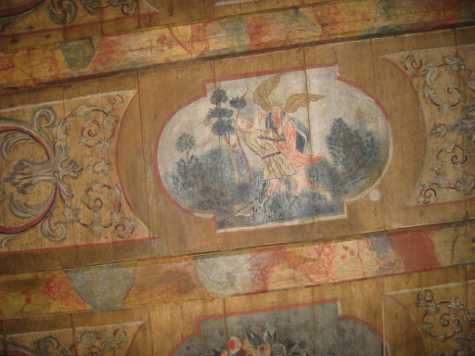
While our host spoke no English, we were able to communicate, learning the design on the ceiling of our room had been painted in the 1500's. The lack of English was actually one reason why we came to Gorlitz. It is not over run by hordes of tourists like Krakow. On our first walk around the old town area, we looked at each other, smiled, and realized this was indeed our kind of town.

We are staying in the yellow building. The middle set of three windows are across the front of our room.

Deciding to eat a little earlier than usual, we set out to find a neat place to eat. Luck was with us, and discovering an enclosed passage off a street that led down to a garden area and ended overlooking the Neisse River and Poland, we had found the perfect spot.. Even the rain that soon started to fall couldn't ruin it, because we were sitting under an umbrella that did an excellent job of shedding the rain. Like we said, it was our kind of town, and our kind of place.
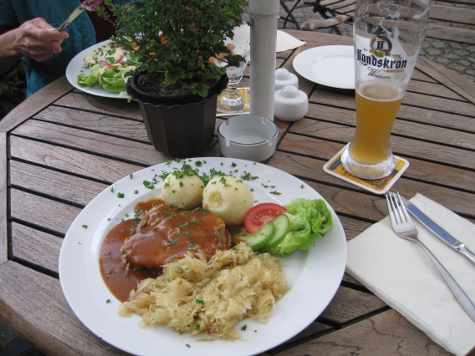
This area is known as Silesia, and their cooking combines German, Polish and Czech styles and foods. They can describe it however they want, I will describe it as roast pork, gravy, potato dumplings and kraut that tasted as good as any I've eaten, and we ate a lot of it when I was growing up.
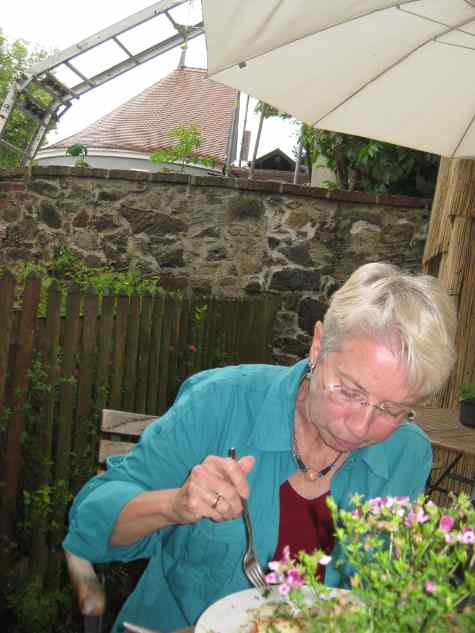
I tried to find out what Linda thought of her pork with white sauce, but for the life of me I couldn't make out what she was saying. It sounded like, murmph, whomlp, grrallph. Our something like that. I thought she knew not to talk with her mouth full, but everytime I asked about the food, her mouth seemed to be full. Not being as dumb as I sometimes appear, I decided that meant it was very tough and chewy. See how perceptive I am. It really surprised me that even though it looked like her food wasn't any good, she had her plate clean long before I did. Maybe it was so bad she wanted to eat it quickly.
June 16 Tuesday
Discovering the delights of Gorlitz and another fabulous meal
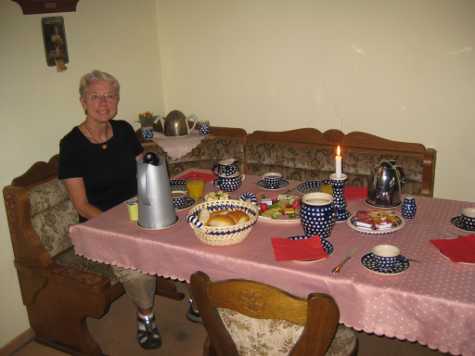
First thing off this morning Linda was faced with another set of steps, but these were gong up only one short flight. The breakfast also proved to be a delight, particularly in that it was light. While Linda ate a small roll with butter and jam, a small piece of meat and cheese, with a cup of yogurt to finish. I went the German route, making a meat and cheese sandwich with the roll, using three slices of each after buttering the roll. My body was wanting another, but my mind won out and I grabbed a cup of yogurt to imitate Linda.

Since it was raining, Linda took it as a sign that the water gods where beckoning her. It wasn't long until I heard the washing machine running, which was Linda using her feet to agitate the clothes in the bottom of the shower. By the time I realized that it was a kodak moment, the wash and rinse cycles had been completed, and she was wanting me to come and be the wringer. That's how we do it when we're on the road in Europe all these months.
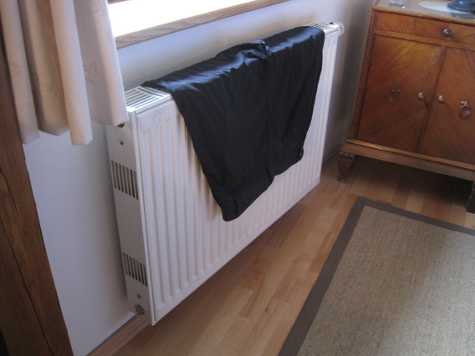
The room also came with a dryer, though the temperature adjustment had to be done by hand, and Linda refused to be the clothes tumbling mechanism.
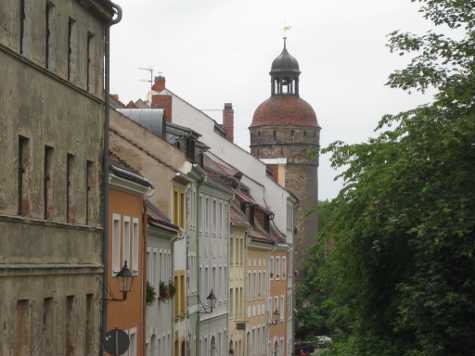
As luck would have it, by the time we were done with the laundry, the rain had stopped. Leaving the room we walked downhill towards one of the ancient city towers, the Nikolai Turm. This view is looking down the street from up above our Guesthouse. Our Guesthouse is the yellow building in the center of the row of buildings..
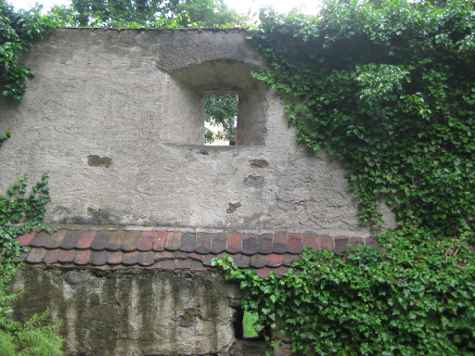
Gorlitz, more than 700 years old, well off the beaten path, was virtually untouched by WWII, so it still has original structures from the past. Beside the Nikolai Turm is the last section of the old city wall. Once cannons came into use, a second wall was erected, and now the area between the walls has been turned into a walkway. It was easy to tell which openings in the wall were for cannon.
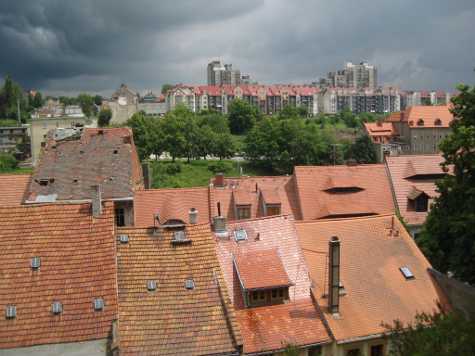
The wall led upwards, not Linda's favorite direction, but at the top was a magnificent view. Those dark clouds were moving our way, but as luck would have it, other than a few sprinkles, nothing came of it. And while I was looking at the highrise apartments across the way in Zgorzelec, Poland, Linda was looking at something else.
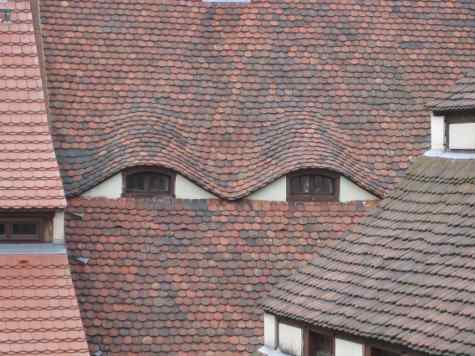
Maybe it was the case of what was looking at her, rather than what she was looking at. She sure had fun finding these eyebrow windows around town.

The older churches, while quite nice on the outside, often times show the effects of the protestant reformation on the inside. We did visit several, but with the restrictions on photos, you had to pay to take any, Linda happily gave up what is probably her least favorite activity, looking at the inside of an ABC, another blasted church.

Gargoyle water spout. This one was low enough on the outside of the church that we could take a better photo.
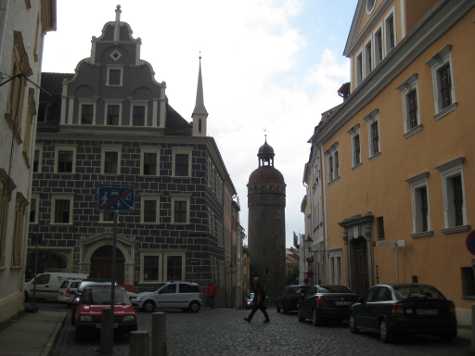
It seems like round every corner is another interesting view.
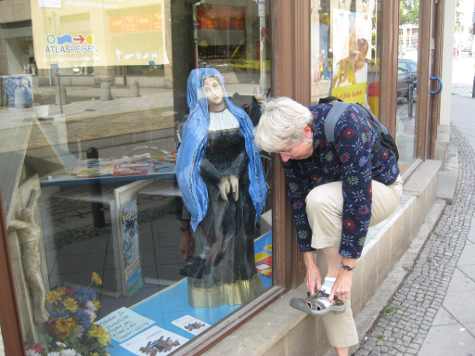
All the time were walking, Linda was having her usual rock in her sandal problem. When I once again found myself talking to no one, and looked back, I wondered if she had finally had enough. It looked to me as if she was seeking divine intervention to get the problem solved once and for all. Or maybe it was to have the strength to remove the rocks as they found their way into her sandal in the future.
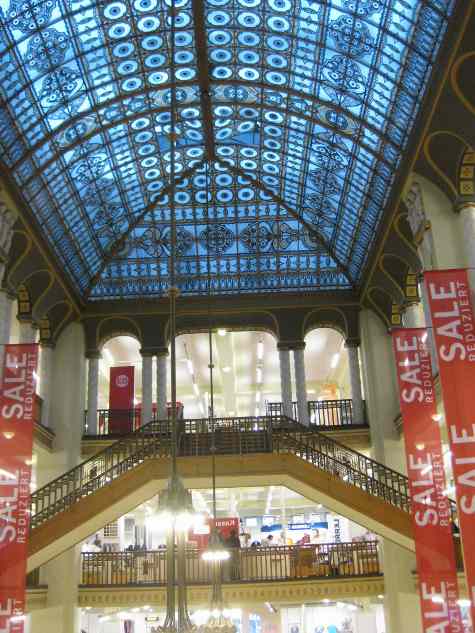
We also visited the major department store in town. Not to shop, but rather to look at its unique curved glass roof. Gorlitz is known for the architecture of its buildings, and we spent time walking the streets, looking and being amazed at what we were seeing. Our path also extended to the Bahnhof to check on the schedule for a potential day excursion tomorrow if the weather improves.
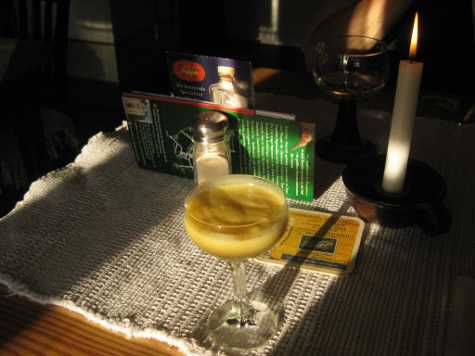
The day ended with the best meal we have had to date during our trip, something we both agreed on. The restaurant was Die Distille, which sits almost underneath the Nikolai Turm. We both had Silesian regional dishes, and have come to the conclusion that the food in tthis part of Germany is awesome. Two nights in a row, two wonderful meals, this one many notches better than last night.
The perfect end to the evening was a glass of Advocaat, and the bill, which was less than half what we would expect to pay in a big city for something not nearly as good. The only problem with Gorlitz is that is the eastern most city in Germany, and really off the beaten path. It is a place where you can walk around town all day and never hear a word of English, let alone see a Rick Steves guidebook, even though he mentions it in his Germany guidebook. It truly is our kind of town.
June 17 Wednesday
Day trippin', trains, trains, medieval ruins, a place with no name.
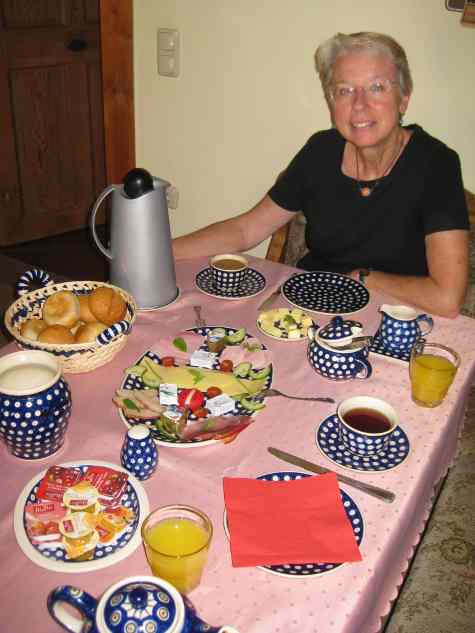
Linda was really enjoying breakfast this morning, even to the point of the dishes.

I had to agree with her, and this was my favorite. The meat and cheese couldn't be beat. Wait maybe she wasn't referring to what was on the dish, but the dish itself. I'll stick with the food, if she wants one of those dishes, she can carry it home.
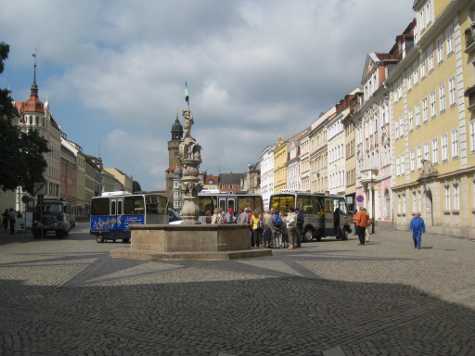
While Gorlitz is not a tourist town, that doesn't mean there aren't tourists. Here is a day tour group from Dresden gathered around their tour guide near the Altemarkt fountain. In a way we going to be joining their ranks today, taking our own day trip to the ruins of a castle.
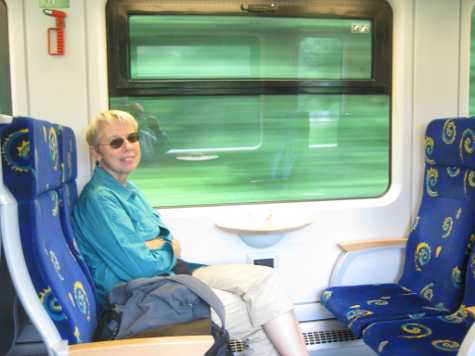
To start, we took a train to the town of Zittau, one of those places that the guide books miss, and tourist visit only because it is a hub that allows you to find the road or railroad to somewhere else.

The cockpit area of our train. Something tells me it is probably more advanced than many American trains, unless they were built in Europe that is.
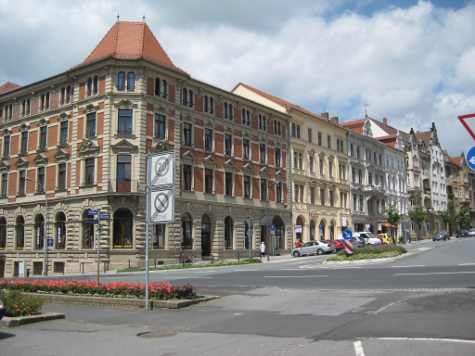
With some time between trains, we walked the four or five blocks down into the center of town. Since it was lunch time, we bought a couple of sandwiches and a cherry strudel, which made for a great lunch, eaten outdoors of course.

We also got a chuckle when we had to wait for the walk/don't walk signal in front of the police station. It was the old East German little man. The signal was new, but we sure do enjoy seeing the little man character. He definitely beats the stupid signals in the US that were probably foisted on us by some lawyer threatening a lawsuit, or a company bribing a politican with a campaign donation.
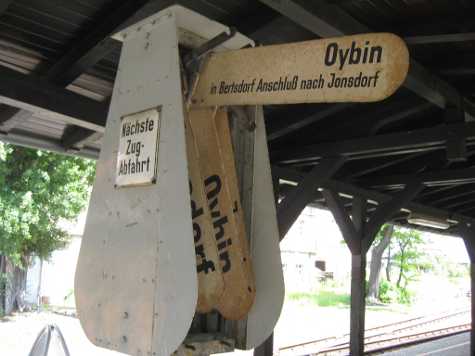
Another kind of signal. The kind that was used before they had electric signals.
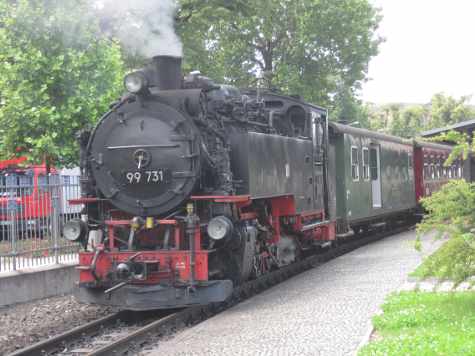
To get to the little town closest to the castle ruins, we would be taking a narrow gauge railroad, where the engine was an oil fired steam locomotive.
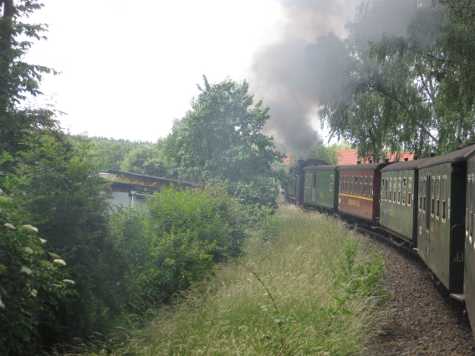
All the way up the hill the smoke poured out of the engine. It made our choice to ride in the last car a good one. Most everyone had boarded the first car and we noticed that while our windows were down the entire trip, no windows in the cars up front ever opened. Maybe it had something to do with all that smoke we were seeing.

Finding the ruins proved to be a bit of a problem, as there were no clear signs pointing out how to get there once we left the train station. With directions from a local hotel keeper, thought they were verbal and then, all in German, we set off. It didn't take Linda long to realize she had forgotten one important fact about visiting castles, whether reconstructed or in ruins. They didn't build them where it was easy to get to, meaning they were usually on a mountain or the top of a steep hill. This one was no exception.
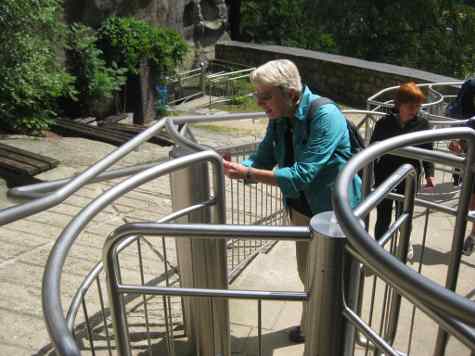
Once we had climb up to the entrance and paid our fee, there was still another obstacle to negotiate before we were within the ruins. Think of it like the difficulty faced in attacking the castle in times of war. We were given a funny shaped coin to insert in a slot, it would only go in one way, then you could go through the turnstile. To say that Linda had a wee bit of a problem determining the correct orientation for the coin would be putting it mildly. Maybe it was the blasts of hot air coming from her mouth that melted the mechanism, or she put the coin in correctly, whatever it was, she finally did get through.

It's also one of those places that doesn't easily lend itself to photographs. Plus it is set up for German tourists, meaning the signs are in German, and there are no nice brochures given out. It's a place to wander around, letting you imagination be your guide if you don't read German.
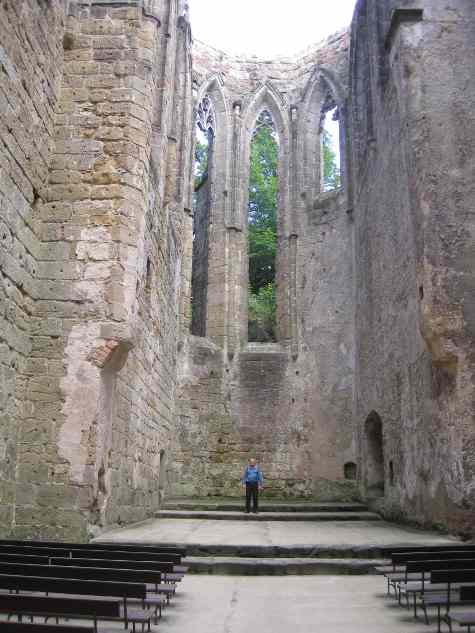
A ruler has to have a chapel, and this one, with a little imagination, had once upon a time been fit for a king.

After another ride on the steam train, we made the mistake of sitting in the next to front car for the return trip, and even with all the windows tightly closed, the refrain about smoke in your eyes was quite appropriate. After that ride, the thought of what our ancestors went through on a long trip by steam train doesn't sound at all glamorous anymore. I'll let the photo speak for itself, because for the next ten minutes after that happened, Linda was gleefully pointing out that she wasn't the only one who got rocks in their sandal, though she was amazed at how big the rock I pulled out was.
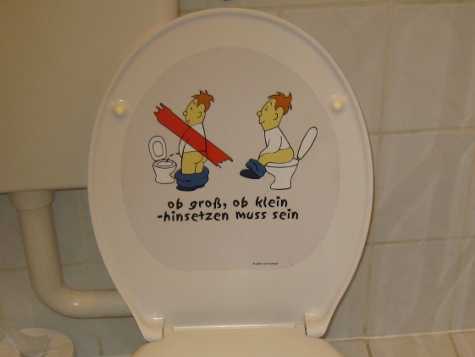
We had decided to eat dinner in Zittau, and while it took some serious walking the streets of town, we stumbled upon another outstanding place to eat. Maybe we have gotten to the point that when a place feels just right, it is, or maybe it is simply dumb luck, but our streak of fabulous meals was extended. It was called the "No Name" restaurant, because the owners couldn't decide on a name for it.
We were the first diners of the evening, but by the time we left it was filled with people who were obviously locals. On our way back to the train station we passed a number of other restaurants which had only a few diners in them so it wasn't that everyone was eating out tonight. The people of Zittau obviously know good food. We each had one of the Sachen specialities, and being pork lovers, there is nothing like eating in a place where they do pork just right.
A pleasant train ride back to Gorlitz,, and then a walk around town, followed by refreshments at an outdoor cafe brought an almost perfect day to an end. It also brought to an end our time in Gorlitz, as tomorrow we head once again to a big city, Dresden, but one that has much to offer.
June 18 Thursday
Goodbye Gorlitz, on the train, Dresden a royal town and wars destruction.
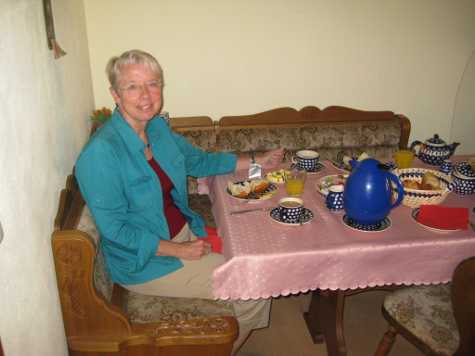
Breakfast was different this morning, but not for what we ate, which was similar to what we have been having. What was different was the service. Our hosts had left for Berlin yesterday morning, and we had the place to ourselves. Breakfast was served by a neighbor of theirs who came over. It was that kind of place, and something that fits perfectly with how we travel.
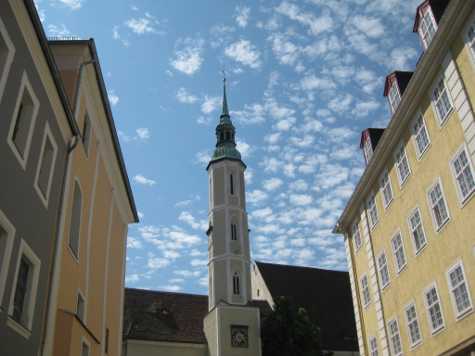
Our plans were to leave Gorlitz sometime around noon, but with several trains to Dresden every hour, it really didn't matter when we left. Linda used the time get in a little Christmas shopping at the Weinachten store in town. I settled for walking around and looking at the town.
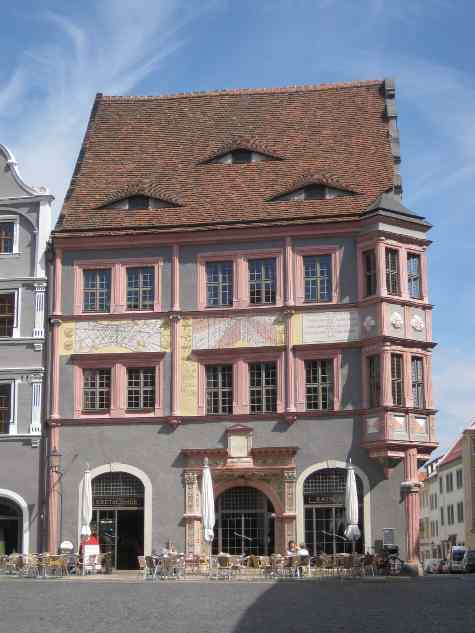
Linda's favorite building in Gorlitz. Who's looking at who?
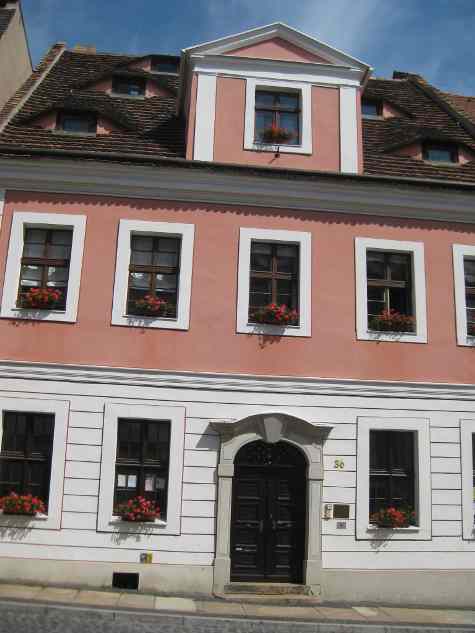
This building has more eyes than first meets the eye. It is also a good example of all the work going on in Gorlitz to renovate the many old buildings in town.
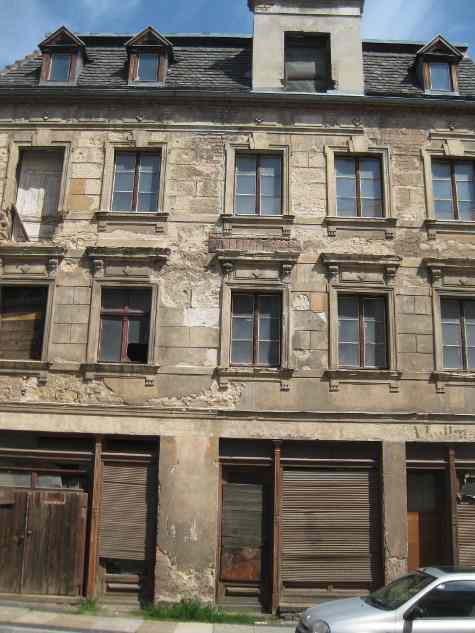
Gorlitz was in East Germany, meaning the communists, meaning many buildings were never fixed up. The building next to the one in the previous photo shows the results of likely being vacant for decades, plus being hundreds of years old, itself.
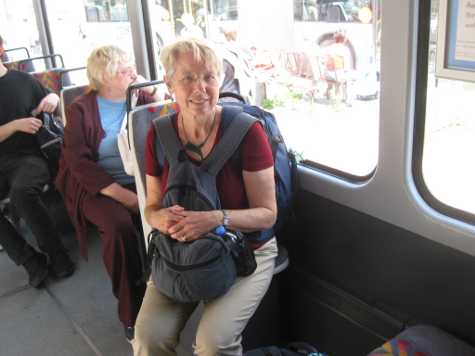
Since we were carrying our packs, we hopped on the tram for a three stop ride to the Bahnhof. We could have walked, but Linda was positive it was a very well spent Euro 1.20 for each of us. At the train station we bought a day pass, which was cheaper than buying tickets for our specific trip, and got on the next train to Dresden.
It was a direct train, but was an RB, or regional, meaning it had some 20 stops during the hour and fifty minute trip. Our destination was the Dresden Hauptbahnhof, and once there it was only a five minute walk to where we hoped to be staying. It was hope to be staying because we had no reservations. It all turned out well, and the cost was some Euro 25 less than we thought it would be.

It was a ten story cookie-cutter hotel, and was one of three in a row. This is exactly what our hotel looks like only it is the one next to ours. This was a compromise on our part, and the first time this year we had stayed in a hotel like this. It wasn't even in the old city, but a short walk would take care of that. The term old city is a misnomer since there is very little old about the old city part of Dresden. The American and British fire bombing raids of February 13-14, 1945 destroyed almost all of what was the old city center. The raids were also responsible for the incineration of over 25,000 civilians, and served no military purpose.
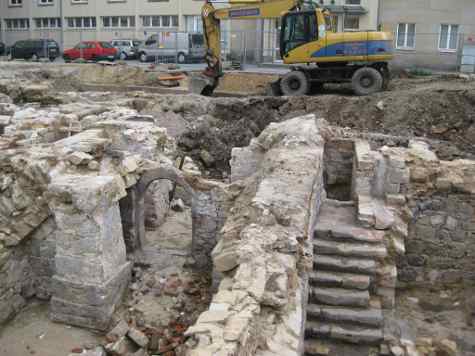
A hole in the ground marks the location of a building at the time of the raids. The communists left huge areas of the city vacant which have been sprouting new buildings over the past twenty years. While the communists did reconstruct some of the most important historical structures such as the former palaces, most of their buildings were big blocky structures with minimal ornamentation.

The Frauenkirke, Church of our Lady, left in ruins by the communists,and finally rebuilt begining in 1992. The dark colored stones are what was original, the light colored ones are new. Once again, it is one of those unless you visit it, you can't appreciate it, places. I'd read about it a number of years ago, but never understood what it was all about until now.
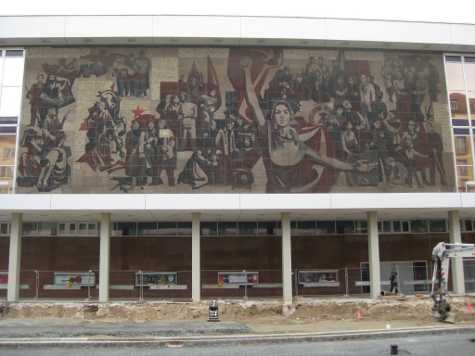
Communist era mural showing the triumph of the people.
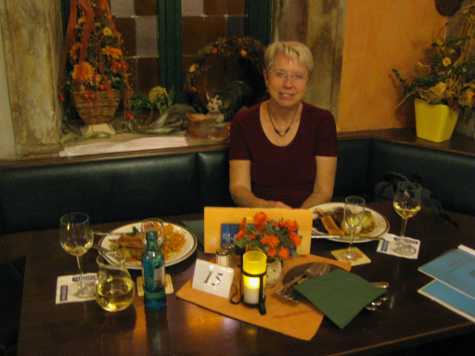
For dinner we descended down into an old cellar restaurant near the altemarket. We were lucky with it being Thursday, so we able to sit in one of the little alcoves that line the wall. The food was just as good as the ambiance, and once again we stuffed ourselves on traditional Sachen dishes. It seems like our string of great meals has no end.
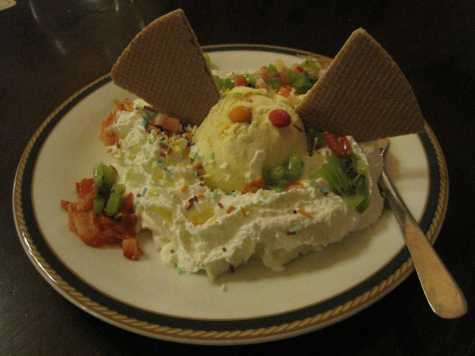
I'm not so sure how traditional my dessert was, but since they served both Saxon and Bohemian dishes, maybe it was. Regardless, it was a good way to end the day. For Linda, with no hills, and an elevator in our hotel, she can take the walking and the few stairs at the sites, making Dresden a good place to visit.
June 19 Friday
Waiting in line, Meissen porcelain, palaces
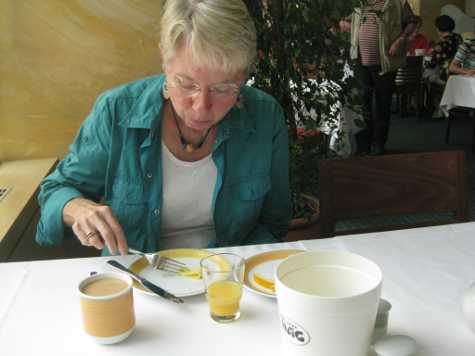
Whether it was yesterday's travel, or the anticipation of today, Linda was the original chow down girl this morning. That will teach me to stop fawning over the meats, and get back to the table tomorrow if I want a breakfast picture with food on her plate.
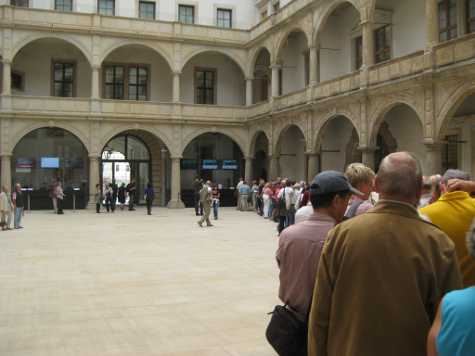
She may have had another reason to eat so fast, which was to make sure we got in line to get our tickets to the Historic Green Vault. The is the Royal treasury of the Saxon princes, and may be the very finest in Europe. The tickets sell out months in advance, but by lining up at the ticket booth in the morning, you may get one of the 275 tickets they put on sale every day.
Luck was with us, and we were able to get tickets for the 12:30 time slot. They really control how many people enter, which makes the experience so much better, if you can get a ticket, that is. Thinking back to the mob scene at the Topkapi Palace in Istanbul, the German way not let as many people get a glimpse of these treasures, but if you get in, the experience is awesome, rather than awful like in Istanbul.
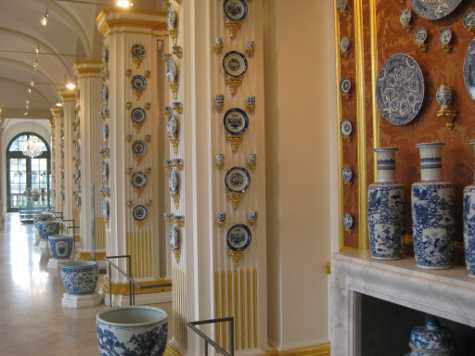
With some two hours to wait before we could enter the Green Vault, the Porcelain Museum beckoned. Started by the Saxon Prince elector, Augustus the Strong, it is the show place of the his collection. Saying he had "A porcelain disease", his collection rivaled any in Europe, but his artisans also developed the greatest of all the European porcelain works, Meissen. Some of the pieces, particularly the early ones with dark red/brown finish before the white and blue finishes were developed, were so beautiful I could truly understand his "disease".
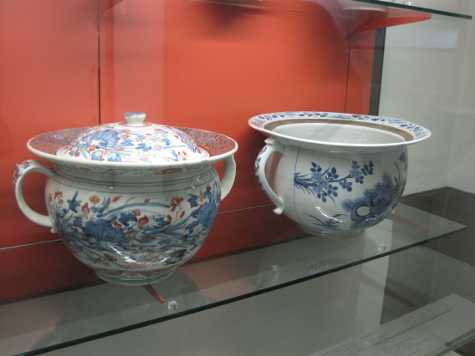
Linda's favorites had more to do with their function than their appearance. Downstairs, across from the restrooms, was a display of chamber pots. These are the ones for the royalty, and as Linda observed, they were royal in size. The ones for the servants required very good aim indeed, either that or they were given so little to eat and drink, the chamber pots didn't need to be very big.

The Porcelain Museum occupied a tiny portion of one of the Palaces. This view from the roof does not begin to do the palace complex justice,it is so huge. It was also this extravagant spending that in the end brought down the Saxons.
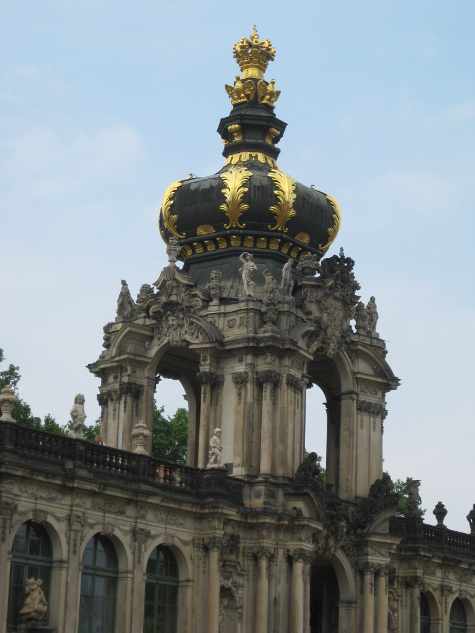
This crown topped the main entrance gate into the courtyard of the Palace.

Linda loved this little fountain across from the Palace. Constructed to honor the victims of a cholera epidemic, the copper salamander type animals with water spouting from their mouths was something she just couldn't get over. I'm not sure whether she had some ulterior motive to how she has me position in this photo, but I did notice she kept motioning me over to where there was a good deal of water splashing out on me.
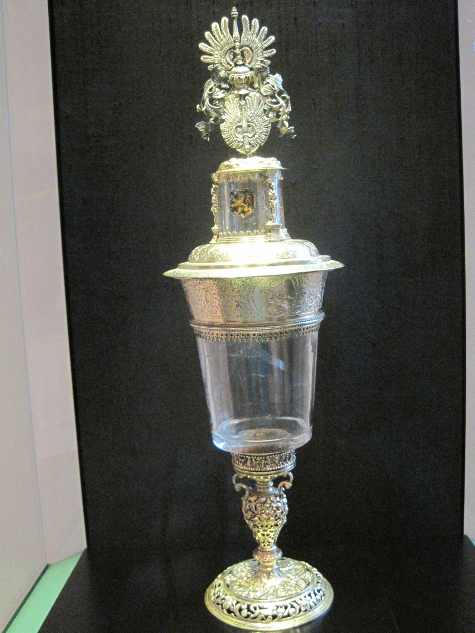
When the time came, we entered the Green Vault, and for the next two hours were enthralled with what we saw. There is gold, silver, though many of the silver items were melted down to finance the costly Seven Year's war, bronze, jewels, ivory, and many other objects in different media. Think of what you would like to have, and they probably had it. The photo is of a rock crystal glass, something that was big with the European royalty of the time.

Something that is currently big in Europe is our President. This item was for sale in the Museum gift shop. They seem to see him as a man with an understanding that we are one world, and that what one country does can have global impacts far beyond its borders.
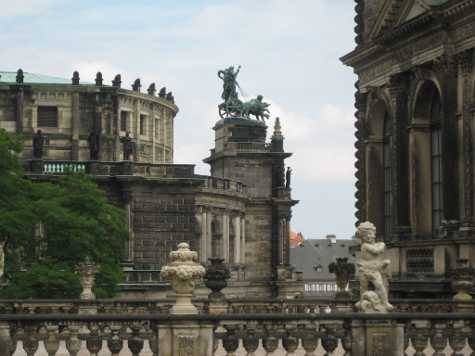
Looking towards the river from the palace area. Once again, dark sandstone is old, light is new. Dresden was a dark spot as far as western TV was concerned during the cold war. That has left them behind in the westernisation of East Germany. Whether that is good or bad is open to debate.That many Dresdeners harbor negative feelings toward "the west", I.e., the US and England for the senseless destruction of their city is a given.
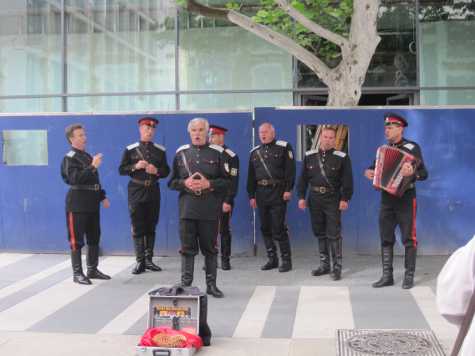
Of the two things that we often see on the streets, this is one of them. Musicians playing or singing for whatever passer-bys choose to give. It is something that we have come to appreciate, and just in the past two days have given a Euro on two different occasions. Once to two young women playing the cello and violin in Gorlitz, and this morning to a young man playing the trumpet in one of the Palace courtyards.
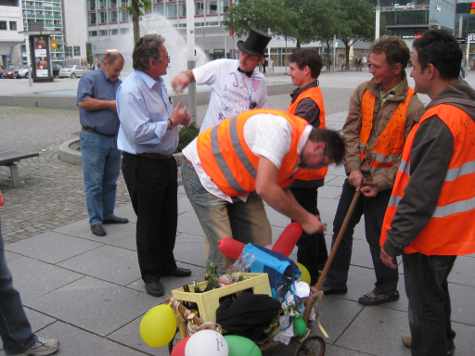
The other is the tradition of the groom going out on the street before the wedding and doing something silly for money. With the weather threatening rain at any moment, this fellow, the one in the top hat, was having trouble getting people to listen to him. I contributed a Euro and got a set of Partygäbelchen, 6 stuck, which was a package of 6 party forks. With that we will end another day, though that did not end it. Germany, land where virtually all the half of me that is not from the German speaking region of Switzerland comes from. It is a place we will return to time and again, simply because I want too, and Linda will also tag along, I hope, even if she doesn't want to. But somewhere in her veins there must be some German blood, why else does she love sauerkraut and Radler so much.
June 20 Saturday
Not quite like home, Interesting museum, getting ready to move on.
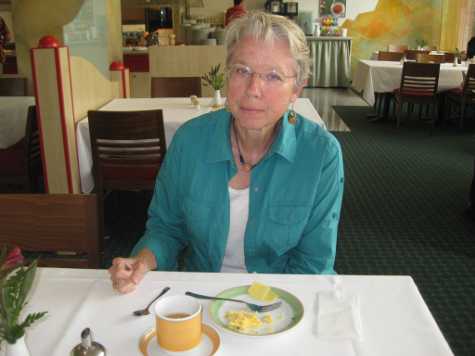
Last evening Linda had mentioned that she might sleep in a little bit this morning, which turned out to be true. She claimed the extra rest was necessary because of all we would be doing on Sunday. I'll just say my opinion differed from hers. Some of the lingering results of that discussion could be seen on her face during breakfast. A meal we just made it to before they stopped serving.
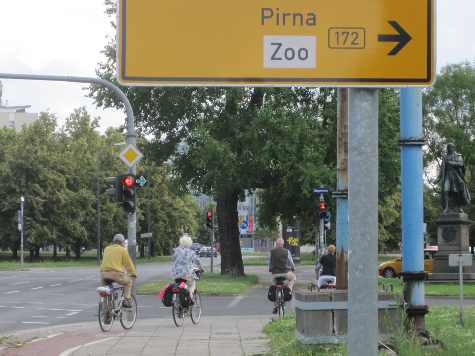
After breakfast we walked to the train station and bought our ticket to Prague. Then we set out for a museum Linda wanted to see. Looking at the map we see that it wasn't far away, but it seemed as if all the roads led away from it, not towards it.
The result was an interesting walk through parks and nearly deserted streets. It also gave Linda an opportunity to observe something she always marvels at, older women riding a bike for transportation.

Getting lost can sometimes led to discoveries you wouldn't make otherwise. Finding some RV's, then reading the signs, we realised this was a RV park right in the middle of the city. It even had electric and water hookups, but no sewer. It was also quite different from RV parks in the states, as try as we might, we couldn't figure out what defined a site, or even to know where there was one. Whatever the method, it seemed to work.
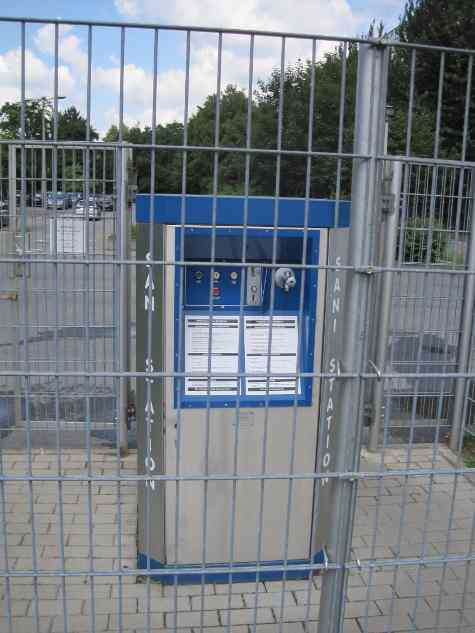
It turned out there was a dump station, it just didn't look like any dump station we'd ever seen. It was a stainless steel cabinet in a wire fence type of enclosure. It took a bit to figure out how it worked, but it appeared that by inserting some Euro coins, the cabinet would opened up, providing access to everything needed to dump your tank, or tanks.
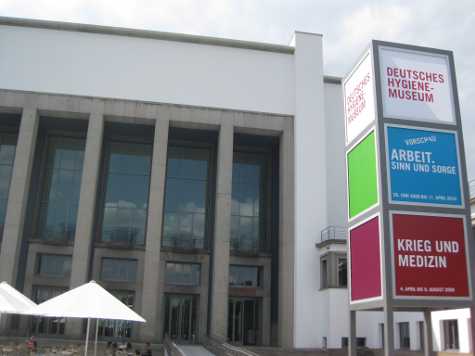
When we finally reached our goal, the Hygiene Museum, it proved to be a wonderful place. We did have a bit of a problem at first with Linda having to backtrack down a number of sets of stairs to check her daypack. A trek which was accompanied by a continuous stream of muttering from her. I think I should be glad I didn't have to hear much of it. I tried the, their country, their culture, their way of doing things, comment, but all it did was increase the intensity of the word stream she was spewing forth.
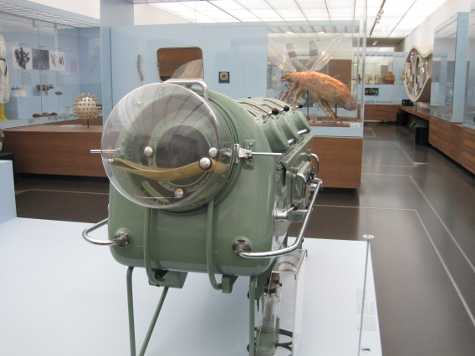
Once we actually got in to see the exhibits, we had a great time.The museum is well signed in English, and we also had English audio guides. Like many of the other museums, photos weren't allowed, but Linda still had to sneak in a couple. Recalling the polio epidemics from our childhood, this iron lung brought back memories.
There were also numerous interactive exhibits, some of which we could do together. For example, we learned Linda has better balance than I do, something she would never have thought. I on the other hand can relax, and lessen my brain activity to a far lower state than she can. Obviously she needs to sleep so much because, because the quality of her sleep is so poor. I sleep very little because my sleep quality was much better. And to think, I sleep that well even with a grizzly bear usually roaring and bellowing next to me.
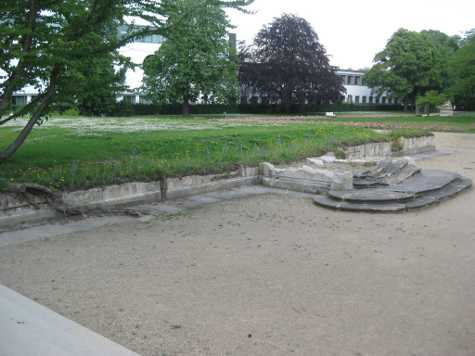
Leaving the museum we were once again reminded of the past. Looking at the photos posted nearby, this appears to be all that is left of a grand building that stood here prior to the Feb.13-14, 1945 fire bombing raids.
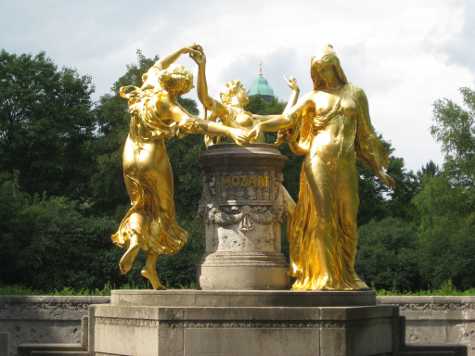
Yet just a short distance away, in a nearby park, is this beautiful memorial to Mozart. Dresden, a city of contrasts.
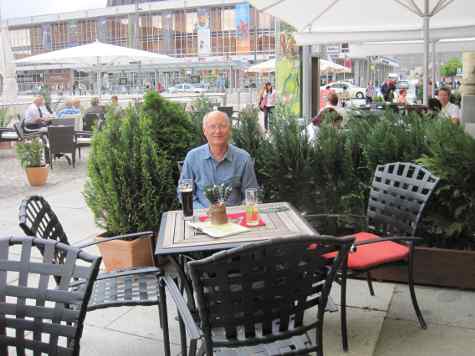
We had spent so much time in the museum, that when we returned, it was time for an early dinner, or very, very late lunch. We decided to have an early dinner at an outdoor cafe, with both of us choosing Bohemian dishes. Maybe that was in preparation of our upcoming trip to the Czech Republic, but the result was another in our ongoing run of outstanding meals.

On our way back to the hotel we stopped at a grocery store. One thing we have learned is that the larger grocery stores can sometimes be found in the indoor shopping centers. We build shopping centers way out from the middle of town and call them malls. Here they build them in town and call them Galleries. In both cases it's a matter of building them where people live. It's also true that people are more likely to want to live near where you build them. In the states we build a so-called downtown mall to lure people there to shop, having long ago driven them elsewhere to live. Then we wonder why no one shops in them. Kind of like the chicken and the egg thing, only we long ago decided to have a chicken in every pot, leaving none to lay any more eggs.
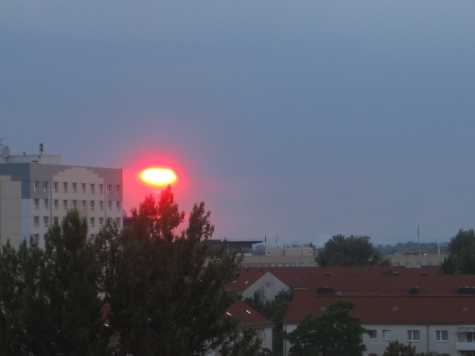
We were also treated to hot air balloons rising over town, this being the fist evening the winds haven't been strongly blowing since we arrived. Later the sun participated in a most spectacular disappearing act with an intensity that we haven't seen since Phoenix.

We closed out the day with something that was very fitting. As our six nights and seven days in Germany were coming to a close, it was mirrored on TV. Having watched it so many times, the fact it was dubbed in German made little difference. Tomorrow we begin a new adventure, making new friends, and beginning, in a sense, the end of our trip, still.we're looking forward more of just having fun living Life.
